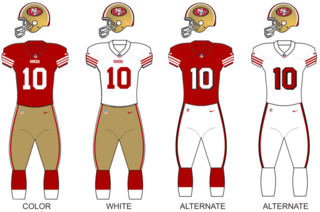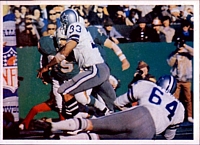
The San Francisco 49ers are a professional American football team based in the San Francisco Bay Area. The 49ers compete in the National Football League (NFL) as a member of the league's National Football Conference (NFC) West division, and play their home games at Levi's Stadium in Santa Clara, California, located 38 miles (61 km) southeast of San Francisco. The team is named after the prospectors who arrived in Northern California in the 1849 Gold Rush.

Candlestick Park was an outdoor stadium on the West Coast of the United States, located in San Francisco's Hunters Point area. The stadium was originally the home of Major League Baseball's San Francisco Giants, who played there from 1960 until 1999, after which the Giants moved into Pacific Bell Park in 2000. It was also the home field of the San Francisco 49ers of the National Football League from 1971 through 2013. The 49ers moved to Levi's Stadium in Santa Clara for the 2014 season. The last event held at Candlestick was a concert by Paul McCartney in August 2014, and the demolition of the stadium was completed in September 2015. As of 2019, the site is planned to be redeveloped into office space.

Robert Bruce St. Clair was an American professional football player who played 11 seasons as a tackle for the San Francisco 49ers of the National Football League (NFL). Known for his intelligence and towering size, at 6 ft 9 in (2.06 m) tall, St. Clair earned All-Pro honors nine times and is enshrined in the Pro Football Hall of Fame. He played college football for the San Francisco Dons and the Tulsa Golden Hurricane.
The 2003 NFL season was the 84th regular season of the National Football League (NFL).

The 1971 NFL season was the 52nd regular season of the National Football League. The Boston Patriots changed their name to New England Patriots to widen their appeal to the entire New England region after moving to their new stadium in Foxborough, Massachusetts, located between Boston and Providence, Rhode Island.
Throughout the years, a number of teams in the National Football League (NFL) have either moved or merged.
Movable seating is a feature of some facilities like stadiums, often known as convertible stadiums, or moduable stadiums. It allows for the movement of parts of the grandstand to allow for a change of the playing surface shape. This allows games that use various shaped playing surfaces such as an oval field, for cricket and/or Australian rules football; or a rectangular field, for football (soccer), rugby league, rugby union, American football, and/or Canadian football; or a diamond field, for baseball; to be played in the same stadium. This is particularly useful in Australia and the United States, where various professional sports with varying field configurations are popular spectator pastimes. The process of conversion from one form to another is time consuming, depending on the stadium it can take from 8 to 80 hours. Many stadiums were built in the United States in the 1960s and 1970s to host both baseball and American football.

The California Victory was a USL First Division professional soccer team based in San Francisco, California. It was an expansion team for the 2007 season, but ceased operation in September of that year after parent club Deportivo Alavés withdrew its support.

Levi's Stadium is an American football stadium located in Santa Clara, California, just west of the much larger city of San Jose, in the San Francisco Bay Area. It has served as the home venue for the National Football League (NFL)'s San Francisco 49ers since 2014. The stadium is located approximately 40 miles (64 km) south of San Francisco. It is named after Levi Strauss & Co., which purchased naming rights in 2013.

A multi-purpose stadium is a type of stadium designed to be easily used for multiple types of events. While any stadium could potentially host more than one type of sport or event, this concept usually refers to a specific design philosophy that stresses multifunctionality over specificity. It is used most commonly in Canada and the United States, where the two most popular outdoor team sports—Canadian football or American football and baseball—require radically different facilities. Football uses a rectangular field, while baseball is played on a diamond with a large outfield. Since Canadian football fields are larger than American ones, the design specifications for Canadian facilities are somewhat less demanding. The particular design to accommodate both is usually an oval, although some later designs use an octorad. While building stadiums in this way means that sports teams and governments can share costs, it also presents some challenges.
The 1957 National Football League season resulted in a tie for the Western Conference championship between the Detroit Lions and San Francisco 49ers. Both finished at 8–4 and had split their two games during the regular season in November, with the home team winning each.

The 1951 Los Angeles Rams season was the team's 14th year in the National Football League and the sixth season in Los Angeles. In 1951, the Rams had an up-and-down season, never winning more than three games in a row, but were able to win eight games and clinch the National Conference after defeating the Green Bay Packers during Week 12 of the season. Los Angeles also led the National Football League in attendance for the second time while in Southern California; the first of 10 consecutive seasons leading the league in attendance. The Rams' largest crowd during the 1951 campaign was 67,186 against the Cleveland Browns during Week 2.
The 1950 San Francisco 49ers season was the franchise's 1st season in the National Football League and their 5th overall. After playing the previous four years in the All-America Football Conference (AAFC), which folded after the 1949 season, the 49ers, Baltimore Colts, and Cleveland Browns all joined the NFL from the AAFC.
The 1951 San Francisco 49ers season was the franchise's 2nd season in the National Football League and their 6th overall. The team was coming off a 3–9 record in 1950.

The San Francisco Bay Area, which includes the major cities of San Francisco, Oakland, and San Jose, hosts six major league sports franchises, with a major women's sports franchise soon to start play, as well as several other professional and college sports teams, and hosts other sports events.

The 1994 season was the San Francisco 49ers' 45th in the National Football League (NFL), their 49th overall, and their sixth under head coach George Seifert. This season was highlighted by a victory in Super Bowl XXIX. The championship made San Francisco the first team to win five Super Bowls. After losing to the Dallas Cowboys in the previous two conference championship games, the 49ers made significant acquisitions in the 1994 free agent market. This included the signing of two-sport star Deion Sanders and Cowboys linebacker Ken Norton, Jr. Sanders had a major impact on the team's success, winning the NFL Defensive Player of the Year Award and recording six interceptions. The 49ers won their division, the NFC West, for the eighth time in nine seasons.

The 1989 season was the San Francisco 49ers' 40th in the National Football League (NFL), their 44th overall and their 1st season under head coach George Seifert. After going 14–2 in the regular season, the 49ers completed the season with one of the most dominant playoff runs of all time, outscoring opponents 126–26, earning their fourth Super Bowl victory and their second consecutive, where they defeated the Broncos, 55–10. They finished with the best record in the NFL for the first time since 1987. Their two losses were by a combined 5 points.

The 2011 San Francisco 49ers season was the franchise's 66th season overall, and 62nd in the National Football League (NFL). It was the first season under head coach Jim Harbaugh and general manager Trent Baalke. The 49ers rebounded from their disappointing 2010 season to end their streak of eight consecutive non-winning seasons. After defeating the St. Louis Rams in week 13 and attaining a 10–2 record, the team clinched the NFC West and made their first playoff appearance since 2002. The 49ers ended the regular season with a 13–3 record, their best since 1997, and earned a bye in the first round of the playoffs. In the Divisional Playoffs they defeated the New Orleans Saints 36–32 and were in the NFC Championship for the first time since 1997, where they lost to the eventual eventual Super Bowl champion New York Giants in overtime by a score of 20–17, coming just short of returning to the Super Bowl for the first time since 1994.

The 2013 season was the San Francisco 49ers' 64th in the National Football League (NFL), 68th overall and third under the head coach/general manager tandem of Jim Harbaugh and Trent Baalke. This marked the first season since 2004 that quarterback Alex Smith was not on the roster as he joined the Kansas City Chiefs. This was the 49ers' final season playing their home games at Candlestick Park before moving into Levi's Stadium for the 2014 season.

The San Francisco Deltas were an American professional soccer team based in San Francisco, California, United States. Founded in 2016, the team made its debut in the North American Soccer League in 2017. The franchise played its home games at Kezar Stadium located at the south-east end of Golden Gate Park.


















